The 2010s and the 1970s are similar in many ways: questionable fashion choices1, U.S. presidents under investigation, Canadian prime ministers named Trudeau, the possibility that nuclear tensions might flare up at any moment. The two decades share something else, as well: during both of these decades, it became easier to discover classic SF. In the modern era, we are seeing ebook reprints mining the output of the past. In the 1970s, we had paper reprints, such as the variously titled Ballantine (or Del Rey) Classic Library of Science Fiction.
As with Timescape Books, the Classic series was largely due to the astute market sense of one editor. In this case, the editor was Judy-Lynn del Rey (she may have had an occasional assist from husband Lester2). Under her guidance, Ballantine and later the imprint that bore her name became a signifier of quality; readers like me turned to her books whenever we had the cash3. The Classic Library of Science Fiction helped to firmly establish the Del Rey publishing house.
Each volume collected the best short stories of a well-known SF or fantasy author. I’m discussing a slew of authors in this essay—alphabetized, because trying to list them in chronological order proved unexpectedly complicated.
The Best of James Blish
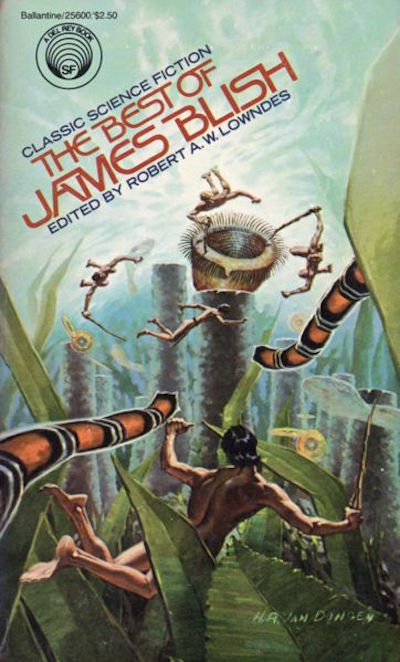
Futurian James Blish (23 May 1921–30 July 1975) may be best known these days as the author of the Cities in Flight series (They Shall Have Stars, A Life for the Stars, Earthman, Come Home, and The Triumph of Time), and his After Such Knowledge series (A Case of Conscience, Doctor Mirabilis, and The Devil’s Day.) Back in the 1970s, many fans knew him as the person doing the Star Trek collections of stories based on the original series. Blish was convinced that SF need not be bound by its pulp origins and published SF criticism under the pen name William Atheling, Jr4.
The Best of Robert Bloch
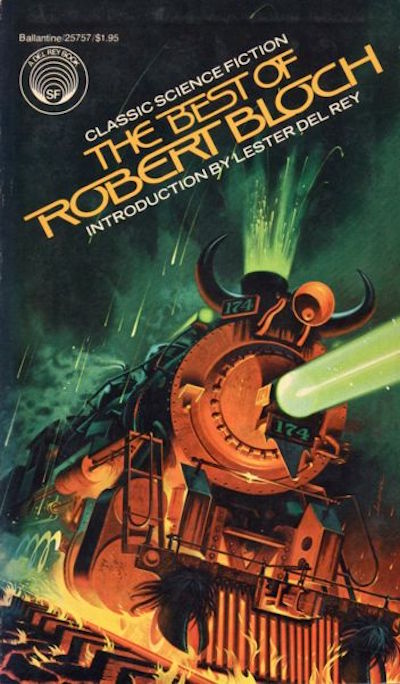
Robert Bloch was a member of the Lovecraft Circle. He published in many genres: mystery, horror, SF, true crime, and more, and was awarded the Hugo, the World Fantasy, the Edgar, and the Stoker. Bloch’s Psycho was the basis for the Hitchcock film of the same name.
The Best of Leigh Brackett
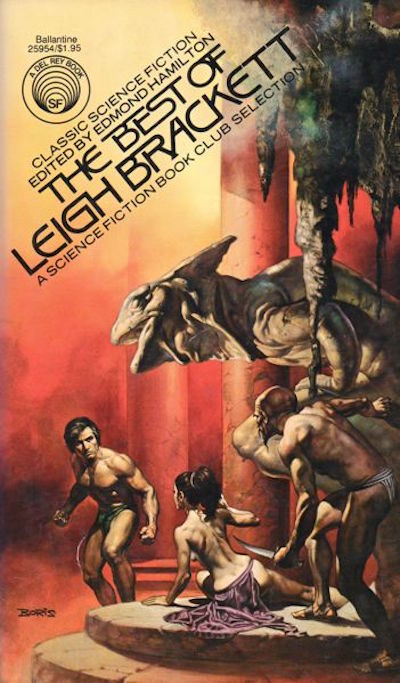
Pulp-era SF was not known for friendliness to women authors, and Leigh Brackett was one of the few women authors of that era. She is known for her planetary romances, many of which shared a setting. Brackett was also a skilled screenwriter, known for her contributions to The Big Sleep, Rio Bravo, Hatari!… oh, and an obscure little film called The Empire Strikes Back.
The Best of Fredric Brown

SF and mystery author Fredric Brown was the master of the comic short-short, works so brief that he might spend more on the postage to submit the stories than he could make from the subsequent sale. Among his best-known stories are “Letter to a Phoenix” (which has not aged well), “Arena,” and “Knock,” which begins: “The last man on Earth sat alone in a room. There was a knock on the door…”
The Best of John Brunner
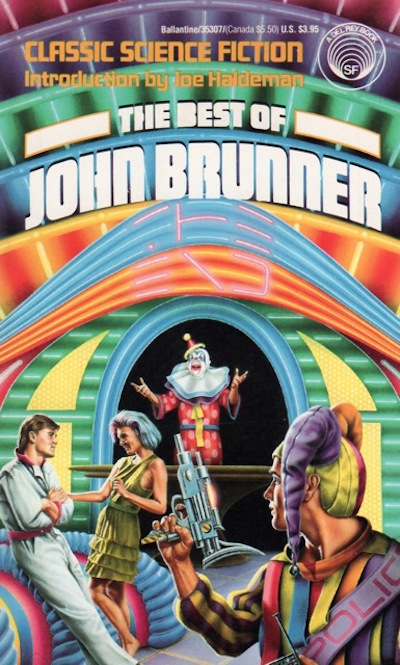
John Brunner’s fiction covered a spectrum ranging from morose to intensely gloomy. Readers intrigued by this collection who want to enjoy his strengths at novel length should seek out Brunner’s thematically-related SF standalone novels: The Jagged Orbit, The Sheep Look Up, Stand on Zanzibar, and The Shockwave Rider. Each book tackles One Big Issue (racial conflict, pollution, overpopulation, and future shock, respectively).
The Best of John W. Campbell
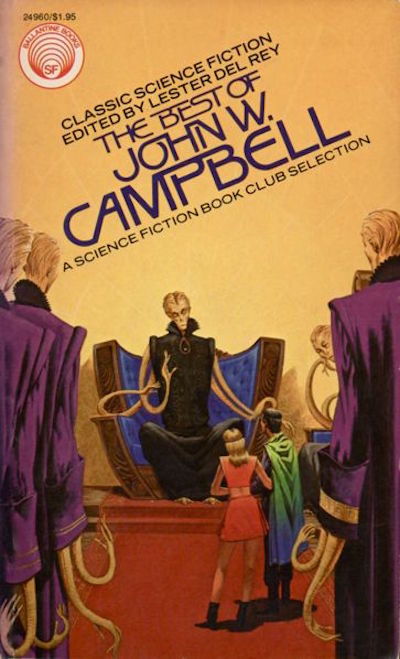
Before he was an influential editor and Patient Zero for several infectious pseudo-sciences, John W. Campbell was a successful writer. His efforts ranged from mood pieces like “Twilight” (not the vampire novel) to star-smashing shoot-em-ups like The Ultimate Weapon. His best-known work is “Who Goes There,” an unsympathetic look at the challenges of assimilation.
The Best of Hal Clement
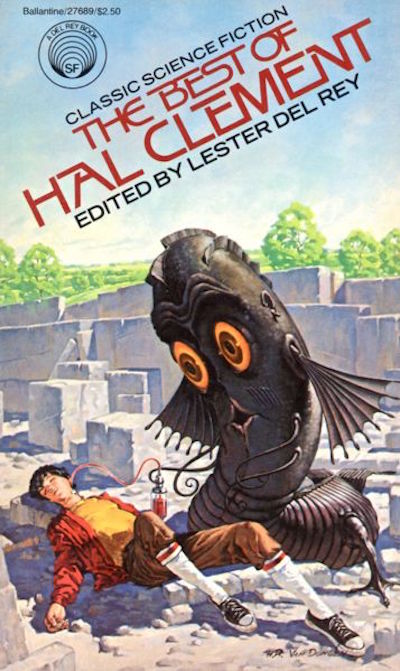
Depending on how narrowly one defines hard SF, the amiable Hal Clement may have been the only hard SF author featured in this series. He could wring a story out of a phase diagram. He wrote about non-Earth-like worlds: planets whose gravity would reduce humans to paste, worlds where we would puff into heated vapour.
Current exoplanet research suggests that we are living in a Hal Clement universe.
The Best of L. Sprague de Camp
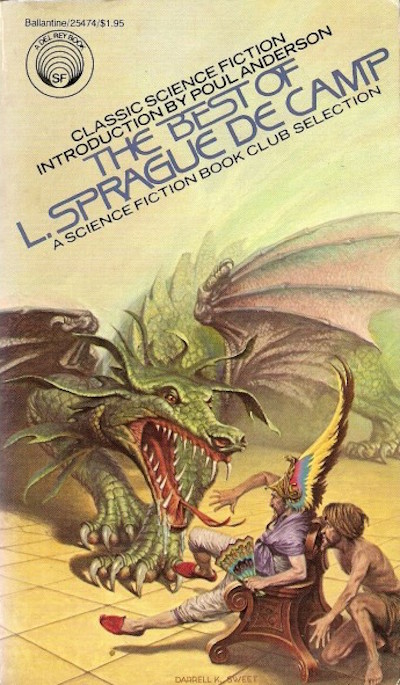
Arguably the dapperest man active in science fiction, L. Sprague de Camp wrote both fiction and non-fiction. He published sword and sorcery, planetary adventure, necrolaborations5, and humorous bar stories (which I found less funny than intended. Though perhaps that was due to the fact that I was reading this book at the time of my father’s funeral.)
The Best of Lester del Rey
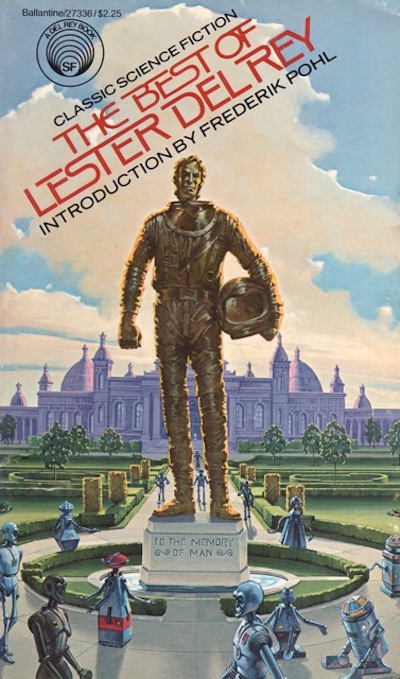
Lester del Rey was both editor and writer. I’m not a fan of his fiction; I’ve always been baffled by the popularity of “Helen O’Loy,” which features a romantic triangle that included a mass-produced robot.
The Best of Philip K. Dick

Philip K. Dick may be best known today as the person whose work has provided material for quite a few movies. He wasn’t big on objective reality as most of the rest of us understand it. He saw depths within depths masked by a thin scrim of illusion. His prose was often energetic, if poorly disciplined.
The Best of Raymond Z. Gallun
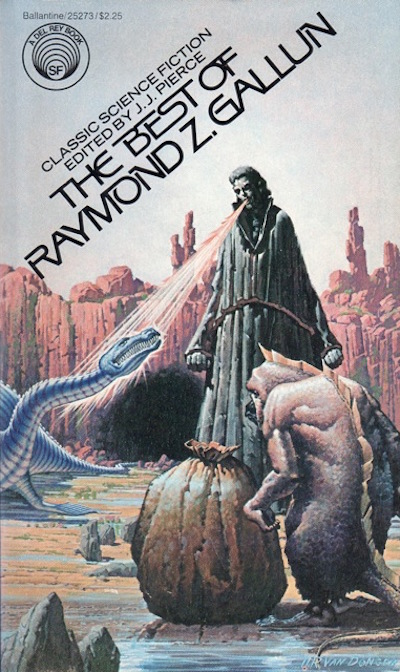
Raymond Z. Gallun got his start at age eighteen, when his 1929 “Space Dwellers” was published. His fiction always showed its pulp-era roots—but sometimes rose above them, as it did in his story “Old Faithful.” After a hiatus beginning in the 1960s, Gallun resumed writing, and he was an active writer well into the 1980s. Not quite Jack Williamson’s eight-decade-spanning career, but still pretty darn impressive.
The Best of Edmond Hamilton
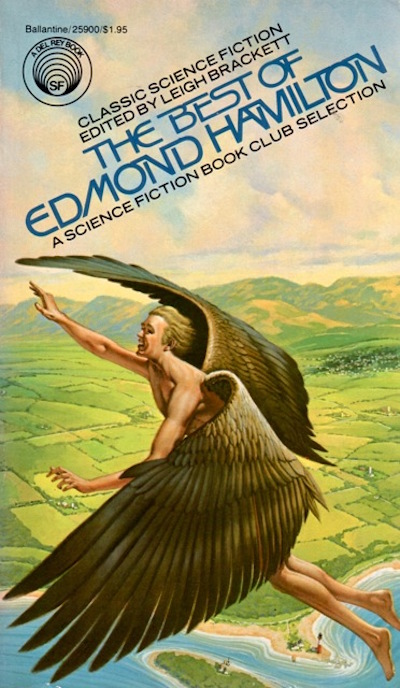
Edmond Hamilton specialized in star-smashing adventures. His prose style was workmanlike at best; his science background was nil. However, he wrote impressive spectacles with high body-counts.
The Best of C. M. Kornbluth

Often found collaborating with Frederik Pohl, C. M. Kornbluth’s bleak, misanthropic fiction allowed magazines like Galaxy and The Magazine of Fantasy and Science Fiction to nudge SF away from Campbell’s vision of a world populated by gung-ho, crew cut-sporting scientists and adventurers. His “The Marching Morons” may be tied with “Harrison Bergeron” for the story most sympathetic to self-pitying nerds. The guy had talent and wrote great stuff. It’s a shame that the long-term effects of his World War Two experiences led to his premature death in 1958.
The Best of Henry Kuttner
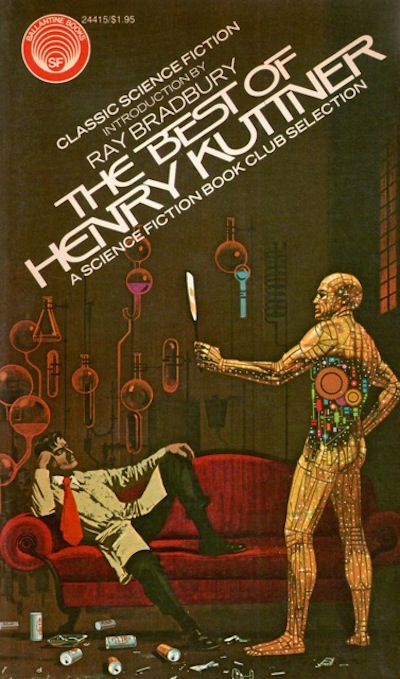
Henry Kuttner was Mr. C. L. Moore. Thanks to Moore and Kuttner’s habit of poorly documented collaboration, it can be very difficult to establish which of them wrote what. Kuttner’s style was slick, his worldview often cynical, and his fiction often quite funny. He also had an eye for talent: he helped Brackett first see print.
Kuttner died in 1958; given how much smaller the field was in those days, losing two authors of Kuttner and Kornbluth’s stature in just two months must have been a disappointment to fans.
The Best of Fritz Leiber
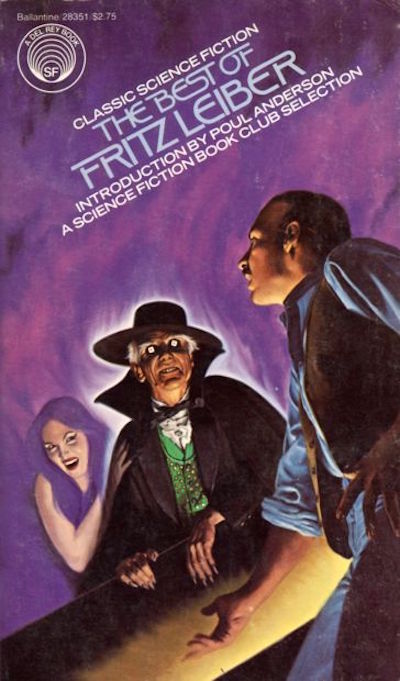
Leiber started publishing in the pulp era; like so many other pulp writers, he was active in many genres. He wrote several books that have been recognized as genre classics. The Fafhrd and the Gray Mouser books are sword and sorcery classics; The Big Time is a time-travel classic; A Spectre is Haunting Texas is dystopian; Conjure Wife is fantasy. Leiber was also an actor, playwright, poet, and essayist.
The Best of Murray Leinster
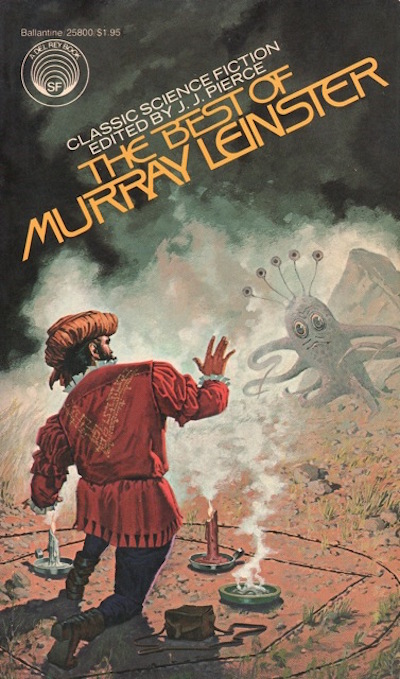
Like Leiber, Murray Leinster (Will Jenkins in real life) wrote in many genres. Over the course of his career, he wrote more than a thousand pieces (novels, stories, essays, plays, etc.). He wrote SF, mystery, romance, Westerns, adventures. He wrote for print, radio, and television.
SF fans may be interested in his story “First Contact,” in which humans and aliens attempt to negotiate peaceful relations. Fans of alternate history may be interested to know that the Sidewise Award for Alternate History takes its name from Leinster’s “Sidewise in Time.”
The Best of C. L. Moore
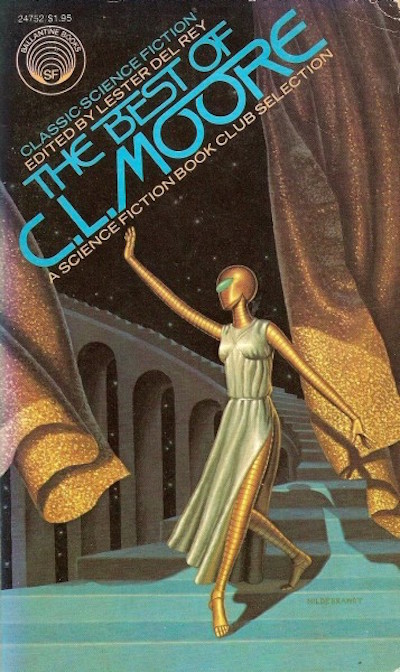
Many of the women working in early SF have been left out of histories. C. L. Moore is one of the exceptions. While her later work is inextricably entangled with that of husband (Henry Kuttner), she was already a star when they married. (In fact, it was the quality of her writing that first interested Kuttner.)
What may interest modern readers: the Northwest Smith stories, which feature a handsome doofus who never met a pretty woman whose death he could not inadvertently instigate. Also her fantasy stories starring warrior Jirel of Joiry, who once fed a vexatious suitor to a demon. One series (Northwest Smith) is SF and the other (Jirel) is fantasy, but they did take place in the same setting, if many centuries apart6. SF or F? Often a matter of interpretation.
Moore would have been the second woman named SFWA Grand Master, had her second husband not intervened. She had developed Alzheimer’s in her old age; he was afraid that she would not be able to cope with the ceremony.
The Best of Frederik Pohl
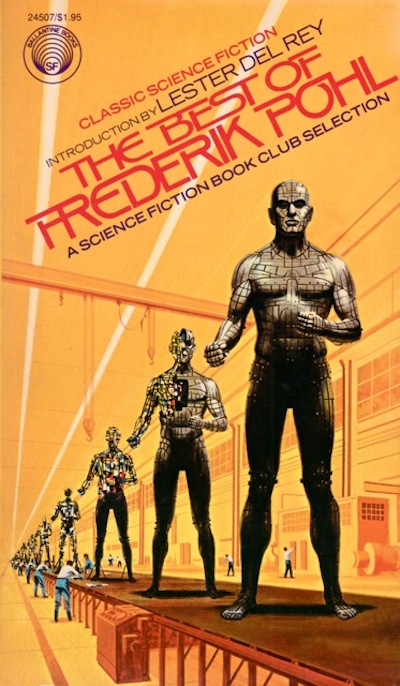
Frederik Pohl had a seventy-five year career during which he was active in almost every possible niche in SFdom as a writer, editor, and fan. (I don’t think he was an artist but I may have missed something.) He won a string of Hugos for his work as magazine editor. While working for Bantam books, he championed classic works such as Delany’s Dhalgren and Russ’s The Female Man. As a writer, he co-wrote classics like The Space Merchants; he also won Hugos for his solo works. He was long active as a fan; he barely missed being there for the very first WorldCon due to some particularly bare-knuckle fannish politics. He was widely known, respected, and liked. He was celebrated in Elizabeth Anne Hull’s tribute anthology, Gateways.
It was an honour to be utterly crushed by him for a Best Fan Hugo in 2010. After all, I was the one who pointed out that Pohl was eligible in the first place.
The Best of Eric Frank Russell

Eric Frank Russell may have been seen as a comic writer, but his satires could have dark overtones. His novels often suggested that there was far more to the universe than we knew, and that additional knowledge would not bring comfort. Despite this, his work was occasionally warm and life-affirming.
The Best of Cordwainer Smith

Cordwainer Smith was the pen name of Paul Linebarger: soldier, expert in psychological warfare, East Asian scholar, and godson of Sun Yat-sen. Smith drew on his Asian expertise when writing SF. His works were far from typical of the SF being published in North America at the time.
The Best of Stanley G. Weinbaum
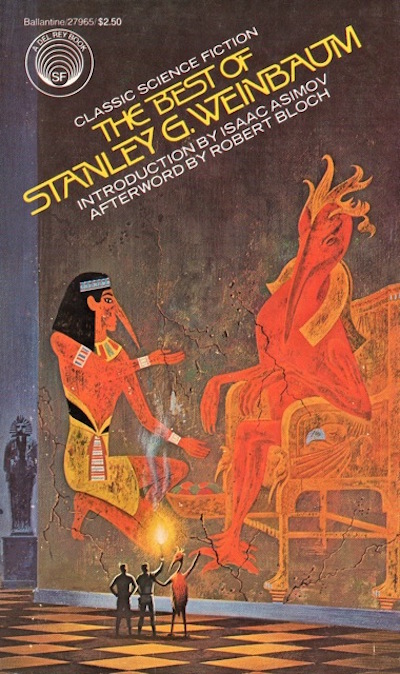
Isaac Asimov compared Stanley G. Weinbaum to a supernova. This was apt both as to brightness (stellar career) and brevity; Weinbaum published for less than two years before he died of cancer. Many of his SF works share the same planetary SF setting, which included a tide-locked Venus and the curiously habitable moons of Jupiter.
The Best of Jack Williamson
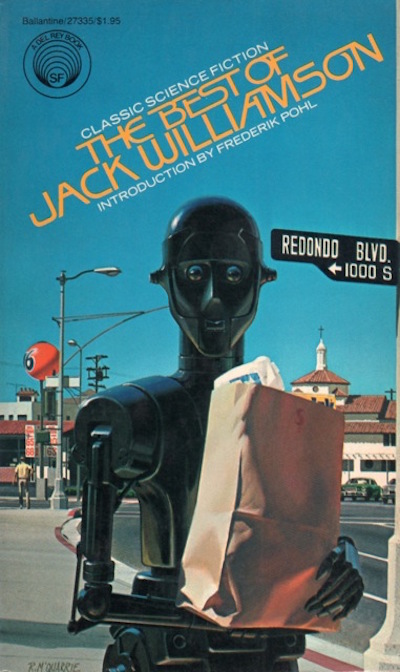
Jack Williamson’s career spanned an astonishing eight decades, from the 1920s to the 2000s, from the pulps to modern times. He wrote classic fantasies like Darker Than You Think, epic space operas like The Legion of Space, and interplanetary thrillers like SeeTee Shock. Readers might enjoy his story “With Folded Hands, in which humans are gifted with all the solicitous robotic caretaking they could desire…and perhaps more.
Buy the Book
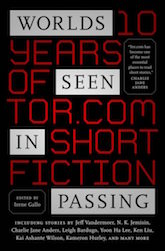

Worlds Seen in Passing: Ten Years of Tor.com Short Fiction
1: OK, only because “questionable fashion choices” is a cross-generational universal. But still, what were we thinking? Shirts made of solidified napalm and tragic sideburns were just the beginning of the horror.
2: Not that Lester was a mere hunky sidekick. He edited Ballantine/Del Rey’s fantasy line and like his wife, had a keen eye for commercial potential. It just goes to show that some SF hubbies are more than just sultry eye candy: all you male SF writers/editors coasting on your looks, try harder!
3: And we had to be judicious in our spending back then. Post-oil-crisis inflation meant that paperbacks could cost as much as a dollar ninety-five! I remember clearly the day I purchased a book for exactly ten times the amount I had spent on my first mass market paperback. I also remember the glazed look on the face of the bookstore clerk as I explained at length the interesting fact that years before he was born, books cost as little as seventy five-cents.
4: I will put this down here and maybe nobody will notice it. Unlike many authors who are called fascists simply because they are political troglodytes, Blish really was a self-described “paper fascist.” Judging by the intro for his fascist utopia A Torrent of Faces, he didn’t think much of the prior art in the fascism field.
5: My coinage for collaboration with a dead author, sans benefit of medium or Ouija board.
6: Thanks to time travel, Northwest did cross paths with Jirel, whose reaction to his rugged, useless charms can be best summed up as a derisive snort.
In the words of Wikipedia editor TexasAndroid, prolific book reviewer and perennial Darwin Award nominee James Davis Nicoll is of “questionable notability.” His work has appeared in Publishers Weekly and Romantic Times as well as on his own websites, James Nicoll Reviews and Young People Read Old SFF (where he is assisted by editor Karen Lofstrom and web person Adrienne L. Travis). He is surprisingly flammable.










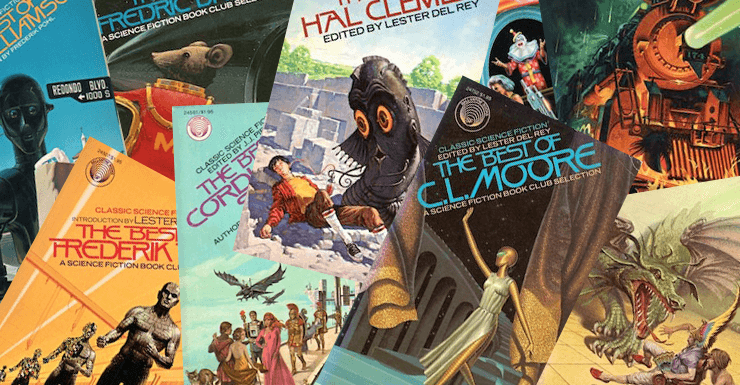
These covers. These covers!
Even today, they range from respectable to excellent. In the 1970s they were flat-out amazing. Several are lovely, most are eye-catching, and every single one is related to what’s inside the book. In a 1970s context, this was much less common than you might think.
Also, the general quality of these collections was quite high. The stories were almost all painfully dated by the 1970s, but they really were “the best of” and many were still worth reading.
Doug M.
Yeah, it was a fine-looking series.
I’ve read all but one. I’ve never even seen a copy of the Brunner, which seems to have been a late addition to the set.
I know I read some subset of these — I distinctly remember seeing the covers on the public library paperback spinners — but at this point I’d be hard-pressed to remember which ones.
I have quite a few of those. It’s interesting that Brackett and Hamilton edited each others “Best of…” (and I have both of those).
If my wife was a writer, you wouldn’t catch me editing her work!
Thanks for this summary. I’ve read a few of these over the years, but there are a lot that I missed. They always did a good job of picking the authors’ best work, and gave additional attention to some excellent authors whose work mostly appeared in the ephemeral world of the magazines.
And, like mentioned above, those covers were uniformly excellent, and captured the spirit of the stories very well.
I’m trying to unsee the PKD cover, although the scary clown on Brunner’s is almost as bad. I loved these books- they gave me a lot of my basic SF knowledge.
A reminiscence on author’s note #3:
I still remember my absolute outrage when, circa 1964 (?), prices on SF trade paperbacks suddenly rose, and my weekly $2 allowance would only let me get 3 new books vs. 4.
Least diverse list ever. You’re trying to tell me the best sci fi was written by a bunch of caucasians…have you even read Nnedi Okorafor.
I’ve read 4 of these (though I’m reasonably familiar with all the authors) and have 3 of them in the editions shown here. I got the Hamilton in a Phoenix Pick reprint, with much inferior artwork.
Interesting that you bring up the necrolaborations of de Camp, but left them out for Fred Pohl. An awfully large number of his collaborations with Kornbluth came after the latter’s death. His wife gave Pohl all of his notebooks and drafts and Fred worked on them for several years. I’ve always suspected that was a way to ensure the widow had at least a small income. And you did forget one of Pohl’s roles: agent.
Nitpick: Will Jenkins was not a pseudonym for Murray Leinster, but rather his real name.
Probably the closest thing we have to something like this right now is Wildside Press’ Golden Age of Science Fiction Megapacks. Those are all single-author anthologies and a really inexpensive way to get the work of authors who worked largely through the 60s. But we really need something similar for more recent authors whose main careers are about as removed from the present as the careers of the authors in these books were from the 70s.
No, because unlike some lists this one actually has women included in it.
Unfortunately Judy-Lynn del Rey never explained her reasoning for excluding Nnedi Okorafor from this series but I’ve wondered if perhaps it might have something to do with Judy-Lynn del Rey having died fourteen years before Okorafor was first published. It’s a strange thing but I’ve noticed a lot of authors absolutely refuse to engage with material they didn’t see on account of having been dead long before it was published.
@7 I remember those days as well. The price of paperbacks shot up above 50 cents apiece, and comic books went up from 12 to 15 cents! I think that was also about the time that gasoline went up above 25 cents a gallon, and I remember my dad went driving around the local towns, only to find that everyone was charging that outrageous price. And because I had gotten myself a paper route, my parents cut off my allowance, leaving me to fend for myself in this torrent of increasing expenses!
10, made my day
I think I’ve read all but two of these, and owned all but one.
The only one I actively disliked was the Hamilton.
I flat out don’t get the appeal of PKD’s books, The Man in the High Castle and Do Androids Dream of Electric Sheep aside. I think my brain is just not wired correctly for his work.
Perhaps tthe wide-spread acclaim and fascination for Lester’s Helen O’Loy may have had something to do with the fact that no one had put this particular idea into print before. (Close analogs, but nothing that got right into it like Helen did.)
JD Nicoll – heh!
Alfred Bester?
I haven’t read most of these, but I have an old and cherished copy of THE BEST OF C.L. MOORE. I like Jirel and Northwest, but I think my favorite story in the collection is the story in the cover art, “No Woman Born”, the transition of a human woman into a robot body, and what it costs her, and what it doesn’t. Though I love all of them, honestly, even the bits that haven’t aged so well–Moore’s prose is so lyrically compelling.
17: As far as I know, Bester wasn’t in the Del Rey series nor in the competing series from Pocket Books. This may be because 1976’s Starlight: The Great Short Fiction of Alfred Bester filled that niche for Bester.
I believe Pocket published the following:
The Best of Poul Anderson
The Best of John Collier
The Best of Randall Garrett
The Best of Harry Harrison
The Best of Damon Knight
The Best of Keith Laumer
The Best of Barry N. Malzberg
The Best of Walter M. Miller, Jr.
The Best of Mack Reynolds
The Best of John Sladek
The Best of Wilson Tucker
The Best of A. E. van Vogt
The Best of Jack Vance
8. Alina Parmar – You do realize that this is a list of reprints during the 1970’s of the 30’s – 60’s era SF authors. If anything you could have mentioned Samuel R. Delany who was writing in the 60’s.
I think you have it backwards with Leinster – Will(iam) F(itzgerald) Jenkins was the real name, Leinster was the nom de plume.
The John Brunner cover looks wonderfully jolly… although the jester-hat guy has a space-gun, and, I notice belatedly, a sash containing most of the word “Police”. Umm…
I never understood, and still don’t, why Andre Norton was excluded from this group. After all, she was the first woman to be Gandalf Grand Master of Fantasy, first woman to be SFWA Grand Master and first inducted by the Science Fiction and Fantasy Hall of Fame – obviously too much of a literary lightweight.
@23,
Andre didn’t write much short fiction
Norton’s absence might be like Bester’s: another publisher composed what amounted to a best of for her before the del Reys could. In 1974, Chilton published The Many Worlds of Andre Norton, which was later reprinted by DAW.
I’d thought that I wasn’t reading much fiction in the 70s but despite that I remember many of these covers (and even a few of the stories). Thanks for putting together this list.
Too bad about footnote 4. I apparently wasn’t paying enough attention.
JDN @10 and 14.
Heh. And I’m glad I’m not the only one who bounced off of PKD.
I didn’t know that DelRey had a history of publishing these best of works. However, as huge fan of Robert E. Howard, their, Fully Illustrated Robert E. Howard Library, books are the best of all the REH reprints. So respectfully done! They gave Howard’s work a classical feel of the old N. C. Wyeth illustrated classics.
Am I the only one who never before heard of Raymond Z. Gallun? I thought it would be a pretty safe bet that I would recognize every name on a series recognizing the greats of SF. But that one came as a surprise.
I think I knew of him from two sources: the Best of listed here and Asimov’s Before the Golden Age.
I have to admire Asimov’s moxie, getting a publisher to pay him to revisit the stuff he liked as a kid. I wonder how Before the Golden Age stands up?
@29: It’s a name I see crop up occasionally and always wonder, “Who?”. The vast bulk of his work came out in the 30s and 40s and he was basically through by the mid-50s. Near as I can tell, he was pretty pulpy.
@31: I reread it a few years ago. Some of it held up, some didn’t. The science is universally terrible, of course, but the writing varies. There’s some good stuff, but it’s mostly forgettable and a bit repetitive. I’d rate it ahead of rereading Doc Smith, but that’s a pretty low bar for me.
@32
I liked Doc Smith. Of course, I was about 15 when I read the Lensman series and haven’t reread it since. Pretty sure various suck fairies have probably smacked it hard.
John Brunner’s fiction covered a spectrum ranging from morose to intensely gloomy
ISTM that’s less than fair; two of the four novels you cite dig happy endings out of plausible near-future morasses (although the ToC for the Brunner collection does run to the gloomy). To that set I’d add The Stone That Never Came Down, which IMO should be read with The Shockwave Rider as a reflection of Brunner’s writing for-and-about both sides of the Atlantic; the latter has essentially a superhero, the former is a bunch of ordinary people working out how to fix the world given a small-seeming techno-miracle.
I also note that the Brunner collection came out (per ISFDB) over two years after JLdR’s death; somebody was keeping up the program for at least a little while. But the whole line is definitely reprinting the classics (as seen 30-40 years ago); Brunner (first published 1951) is probably the newest author on that list.
@31 James Nicoll I haven’t read Before the Golden Age in many years (and there is a chance I may be mixing it up with In Memory Yet Green) but Asimov wrote longer than usual prefacing material for each story, detailing when he read it and/or how it was relevant to his life. I’ve read the candy store and Columbia mythology enough times, and in enough places to confuse them, but I’m pretty sure Asimov wrote quite a bit of new material (of course, if he is to be believed, that was probably dashed off at the speed of thought given his typing speed and composition style). As an example, I seem to remember Asimov commented on Edmond Hamilton’s The Man Who Evolved regarding cosmic radiation and how it wouldn’t “evolve” a single organism but only works on populations. I kinda sorta remember maybe that Asimov said Simak’s Sidewise in Time influenced his attitude towards alternate history too.
I don’t know if all the stories hold up, but even now, over twenty years since I last picked up this book I think I also remember Tumithak of the Corridors, Awlo of Ulm, Tetrahedra of Space, and The World of the Red Sun (the first story to make little me cry).
@31: Asimov says that the idea of “Before the Golden Age” came to him in a dream (and Janet suggested that he try to make the dream come through). “He Who Shrank” is a standout story from “Before the Golden Age.”
@29: I just read a story by Gallun in “Adventures in Time and Space” (which I picked up because it had several of this year’s retro-Hugo nominees in it). Not a bad story (“Seeds of the Dusk”) – the standout character was an intelligent crow-like bird (in a far-future dying Earth).
I read The Best of Hal Clement recently, it was SOOOOOOO GOOOOOOOOOOOOD!!!!!!!!!!!!!!!!!!!!!!!!!!!
To the author – Nicely done, both the OP and #10.
#8 is almost too perfect a pitch, straight over the plate…
#29 – Interesting summary of his work here:
http://www.sf-encyclopedia.com/entry/gallun_raymond_z
I just wish I knew the Sci-Fi book of short stories that my dad had circa 1976, because of the atmospheric story in it that I read. I think it was the first story in the book. I think it’s quite short. And it concerns a (young) Egyptologist working on his own in the desert. He is haunted by some sort of wild dog or jackal. And it exerts an eerie force on him as if it is an ancient god. He ends up digging a pit as his own grave. And the last we see is the dog staring down at him from above.
I spent several years searching these all out about a decade ago. Sure not every collection is going to be a grand slam but each one had at least one story, if not more, that made it worth the price of admission.
You’ll see them pop up in used book stores or sales pretty regularly and I recommend picking them up.
I’m not quite sure of the point of this post – after lauding Judy Lynn Del Rey for the Best of series, it spends much of its time running down her choices.
“SF and mystery author Fredric Brown was the master of the comic short-short” … I thought the funniest thing in The Best of Fredric Brown was in the introduction by Robert Bloch. Bloch said that Brown was always plagued by his editors misspelling “Fredric”, and that he (Bloch) wouldn’t be surprised if Ballantine misspelled Brown’s name in this tribute to him.
Ballantine didn’t. But they did misspell “Block”. I always wondered if that was a legitimate typo or a subtle joke from del Rey to Bloch?
Just introduced my son to Fritz Leiber’s fiction via his collection in this series. My copy has a completely different cover, though – unlike the cover here which is a take on “Roll Them Bones”, it seems to be a generic SFnal desert scene.
When Ballantine’s “The Best of …” series began coming out (in 1975?), I read them almost religiously, even though I had read most of the stories in them in other s-f anthologies by then. Probably my favorite author at the time was Robert A. Heinlein, and I kept waiting for “The Best of Robert A. Heinlein” to appear. One never did. I wondered why? Wouldn’t he give permission? Maybe it was because Ace Books had published an excellent collection, “The Worlds of Robert A. Heinlein”, a few years before. Between that and his own hardcover collections, all of Heinlein’s best short stories were already in print. Still, I was disappointed that Heinlein never got Ballantine/Judy-Lynn Del Rey’s classy “Best of” treatment.
The series was in full swing when the first “Star Wars” movie came out in mid-1977. Much of the publicity for “Star Wars” reprinted the concept art and the poster by Ralph McQuarrie. I thought that he would have been a great s-f book cover or magazine artist, and I was delighted to see his cover for “The Best of Jack Williamson”. And then nothing besides his covers for many of the “Star Wars” novelizations and other merchandising. Did he ever do any other non-“Star Wars” s-f book art? How did del Rey get him? (Well, Ballantine had published the original “Star Wars” novel.)
#3 Books cost as little as 75¢? I remember when they cost only 35¢.
#15 Lester del Rey’s “Helen O’Loy” was an elegant precursor of Cordwainer Smith’s Lady Panc Ashash in “The Dead Lady of Clown Town”, who had her recorded memory pattern put into a robotic body – not elegantly humanoid — after her death. That was a precursor or Sir Arthur C. Clarke’s comment that future mankind would be able to forestall death by having his/her brain transferred into a metal can. Life might not be worth living after that, but death would be avoided.
#32 & #33 Did Doc Smith have enough good short stories to be included? He mainly wrote novels.
I still have boxes of many of the same paperbacks. Hoping my kids would enjoy them as well as I did. Might mention the Airmont classic series as well from the 60’s. Jules Verne and other items from the 1800s.
Those covers!
I want to read most of them.
All of the authors are significant to the field but if they were not, the art design for this series would be noteworthy on its own. _Particularly_ in the context of the 1970s where half the covers seemed to be Powers blobs or gratuitous nudes.
I have all of these home, hotly coveted and sought out during my teen years. I believe there are more, though, aren’t there? I’m at work right now, but I’m certain there’s a Best of H.Beam Piper somewhere…
This line: <i>Henry Kuttner was Mr. C. L. Moore.</i> made me giggle.
the interesting question about “letter to a phoenix” is whether it’s set in our future or our past.
I don’t think Piper was ever published by Ballantine/Del Rey. When his material began to be republished in the 1970s, it was Ace that reprinted it. If there was ever a Best Of, I missed it.
Frederic Brown’s “Knock” is one of the best SF pieces of all time, and I’ll fight anyone who says otherwise. I didn’t know he was also the author behind “A Letter to a Phoenix”, the search for which is what brought me here.
#45 There was a Best of E. E. “Doc” Smith collection, published by Orbit in the UK in 1975, and by Jove/HBJ in the US in 1979. He didn’t write many short stories; in fact this collection includes one or two excerpts from his novels to fill it up.
Can anyone identify the story on the cover of the John Brunner volume?